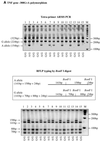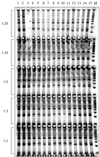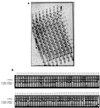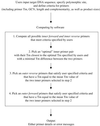An efficient procedure for genotyping single nucleotide polymorphisms - PubMed
- ️Mon Jan 01 2001
An efficient procedure for genotyping single nucleotide polymorphisms
S Ye et al. Nucleic Acids Res. 2001.
Abstract
Analysis of single nucleotide polymorphisms (SNPs) has been and will be increasingly utilized in various genetic disciplines, particularly in studying genetic determinants of complex diseases. Such studies will be facilitated by rapid, simple, low cost and high throughput methodologies for SNP genotyping. One such method is reported here, named tetra-primer ARMS-PCR, which employs two primer pairs to amplify, respectively, the two different alleles of a SNP in a single PCR reaction. A computer program for designing primers was developed. Tetra-primer ARMS-PCR was combined with microplate array diagonal gel electrophoresis, gaining the advantage of high throughput for gel-based resolution of tetra-primer ARMS-PCR products. The technique was applied to analyse a number of SNPs and the results were completely consistent with those from an independent method, restriction fragment length polymorphism analysis.
Figures

Schematic presentation of the tetra-primer ARMS-PCR method. The single nucleotide polymorphism used here as an example is a G→A substitution, but the method can be used to type other types of single base substitutions. Two allele-specific amplicons are generated using two pairs of primers, one pair (indicated by pink and red arrows, respectively) producing an amplicon representing the G allele and the other pair (indicated by indigo and blue arrows, respectively) producing an amplicon representing the A allele. Allele specificity is conferred by a mismatch between the 3′-terminal base of an inner primer and the template. To enhance allelic specificity, a second deliberate mismatch (indicated by an asterisk) at position –2 from the 3′-terminus is also incorporated in the inner primers. The primers are 26 nt or longer, so as to minimize the difference in stability of primers annealed to the target and non-target alleles, ensuring that allele specificity results from differences in extension rate, rather than hybridisation rate. By positioning the two outer primers at different distances from the polymorphic nucleotide, the two allele-specific amplicons differ in length, allowing them to be discriminated by gel electrophoresis.

(Above and previous two pages) Results of tetra-primer ARMS-PCR and validation using the restriction fragment length polymorphism typing method. (A) the TNF gene –308G→A polymorphism; (B) the IL6 gene –174G→C polymorphism; (C) the AGTR1 gene 1166A→C polymorphism.

(Above and previous two pages) Results of tetra-primer ARMS-PCR and validation using the restriction fragment length polymorphism typing method. (A) the TNF gene –308G→A polymorphism; (B) the IL6 gene –174G→C polymorphism; (C) the AGTR1 gene 1166A→C polymorphism.

(Above and previous two pages) Results of tetra-primer ARMS-PCR and validation using the restriction fragment length polymorphism typing method. (A) the TNF gene –308G→A polymorphism; (B) the IL6 gene –174G→C polymorphism; (C) the AGTR1 gene 1166A→C polymorphism.

Tetra-primer ARMS-PCR assays with different concentrations of the outer primers. Shown here are tetra-primer ARMS-PCR assays for the AGTR1 gene 1166A→C polymorphism, with the same amounts of inner primers but different amounts of outer primers (i.e. the ratios of outer primers to inner primers in terms of their final concentration being 1:20, 1:10, 1:5, 1:3 or 1:1, respectively).

Results of tetra-primer ARMS-PCR reactions with the TNF gene –308G→A polymorphism, with touchdown or normal cycling conditions.

Analysis of tetra-primer ARMS-PCR products using the MADGE system. (A) PCR products for the IL6 gene –174G→C polymorphism were subjected to MADGE gel electrophoresis. The gel was then stained with Vistra green and scanned using a fluorimager. (B) The MADGE gel image in (A) was analysed using the Phoretix 1D Advanced computer software in which all 96 lanes are laid out in tandem to facilitate genotype scoring. Lanes 11H and 12H, negative controls where no DNA template was included in the PCR reactions; lanes 6H, 7H and 12H, PCR failed.

Flow chart of the tetra-primer ARMS-PCR primer design program.
Similar articles
-
Modified tetra-primer ARMS PCR as a single-nucleotide polymorphism genotyping tool.
Mesrian Tanha H, Mojtabavi Naeini M, Rahgozar S, Rasa SM, Vallian S. Mesrian Tanha H, et al. Genet Test Mol Biomarkers. 2015 Mar;19(3):156-61. doi: 10.1089/gtmb.2014.0289. Epub 2015 Feb 6. Genet Test Mol Biomarkers. 2015. PMID: 25658900
-
A high-throughput MS-PCR method on MADGE gels for ANG II type-1 receptor A1166C polymorphism.
Hunt CC, Burley JE, Chapman CM, Beilby JP. Hunt CC, et al. Physiol Genomics. 1999 Aug 31;1(2):71-3. doi: 10.1152/physiolgenomics.1999.1.2.71. Physiol Genomics. 1999. PMID: 11015563
-
Guan F, Yang LG, An JT, Liu SR, Shi GQ. Guan F, et al. Yi Chuan. 2005 Jul;27(4):579-83. Yi Chuan. 2005. PMID: 16120582 Chinese.
-
Restriction enzyme mining for SNPs in genomes.
Chuang LY, Yang CH, Tsui KH, Cheng YH, Chang PL, Wen CH, Chang HW. Chuang LY, et al. Anticancer Res. 2008 Jul-Aug;28(4A):2001-7. Anticancer Res. 2008. PMID: 18649739 Review.
Cited by
-
Naderi M, Hashemi M, Hazire-Yazdi L, Taheri M, Moazeni-Roodi A, Eskandari-Nasab E, Bahari G. Naderi M, et al. Braz J Infect Dis. 2013 Sep-Oct;17(5):516-20. doi: 10.1016/j.bjid.2012.12.009. Epub 2013 Jul 2. Braz J Infect Dis. 2013. PMID: 23830055 Free PMC article.
-
Shah R, Khidri FF, Waryah YM, Nigar R, Mahmood A, Shaikh H, Awan MQ, Ujjan ID, Waryah AM. Shah R, et al. Biometals. 2024 Apr;37(2):447-459. doi: 10.1007/s10534-023-00561-2. Epub 2023 Dec 12. Biometals. 2024. PMID: 38085405
-
Chen L, Liang Y, Qiu J, Zhang L, Chen X, Luo X, Jiang J. Chen L, et al. J Biomed Sci. 2013 May 28;20(1):32. doi: 10.1186/1423-0127-20-32. J Biomed Sci. 2013. PMID: 23711151 Free PMC article.
-
Inagaki T, Asahi S, Ogawa K, Nakagawa T, Ohkura T, Osada Y, Nikai T, Yamada K, Yagi T, Uchiya K-i. Inagaki T, et al. Microbiol Spectr. 2024 Apr 2;12(4):e0233923. doi: 10.1128/spectrum.02339-23. Epub 2024 Feb 16. Microbiol Spectr. 2024. PMID: 38363108 Free PMC article.
-
An insight into clinical outcome of XPG polymorphisms in breast cancer.
Malik SS, Mubarik S, Masood N, Khadim MT. Malik SS, et al. Mol Biol Rep. 2018 Dec;45(6):2369-2375. doi: 10.1007/s11033-018-4401-7. Epub 2018 Sep 25. Mol Biol Rep. 2018. PMID: 30255276
References
-
- Collins F.S., Brooks,L.D. and Chakravarti,A. (1998) A DNA polymorphism discovery resource for research on human genetic variation. Genome Res., 8, 1229–1231. - PubMed
-
- Kwok P.Y., Deng,Q., Zakeri,H., Taylor,S.L. and Nickerson,D.A. (1996) Increasing the information content of STS-based genome maps: identifying polymorphisms in mapped STSs. Genomics, 31, 123–126. - PubMed
-
- Brookes A.J. (1999) The essence of SNPs. Gene, 234, 177–186. - PubMed
-
- Collins F.S., Patrinos,A., Jordan,E., Chakravarti,A., Gesteland,R. and Walters,L. (1998) New goals for the U.S. Human Genome Project: 1998–2003. Science, 282, 682–689. - PubMed
Publication types
MeSH terms
Substances
LinkOut - more resources
Full Text Sources
Other Literature Sources